Song Stories. Skydancer: Ghost Of The Moors
Categories: Composing Projects Completed, Song Stories
I’ve been asked to compose a song for Hen Harrier Day 2020 which will be an online event. The Bridge Singers have recorded the song, and their video of it will be launched on the Hen Harrier Day website in August, but in the meantime Hen Harrier Action would like others to record or learn the song. To this end I have created, with the help of The Bridge Singers a Learning Video. The script for that is below. You can read the script or watch the video.
Here’s the Skydancer: Ghost Of The Moors Learning video!
If you want to find out more about how to participate with the song on Hen Harrier Day 2020, click here: Hen Harrier Day 2020 Song
The script from the video:
In April 2020, as we all stayed at home due to the Covid-19 lockdown, I was asked by the friend (Jo) of a friend (Shuna) if I would consider composing something for the 2020 Hen Harrier Day in August. Shuna is in my choir The Bridge Singers, and Jo had heard our enjoyable attempts to stay singing together during the lockdown through our remote recording videos. I had recently written songs featuring bullfinches and Stellar’s Eiders which Shuna had been part of performing, and I have also in recent years written songs about chaffinches and great crested grebes amongst others, so my reputation as a composer of songs about birds is well-established!
The idea was that the song could be sung, or at least joined in with, by participants on Hen Harrier Day 2020. I would compose the song and The Bridge Singers would do their remote recording thing, then I would collate the video and provide a full recording and a learning video to help other groups and individuals learn the song for their own video, or at least be able to sing along on Hen Harrier Day 2020.
The song consists of three main music ideas.
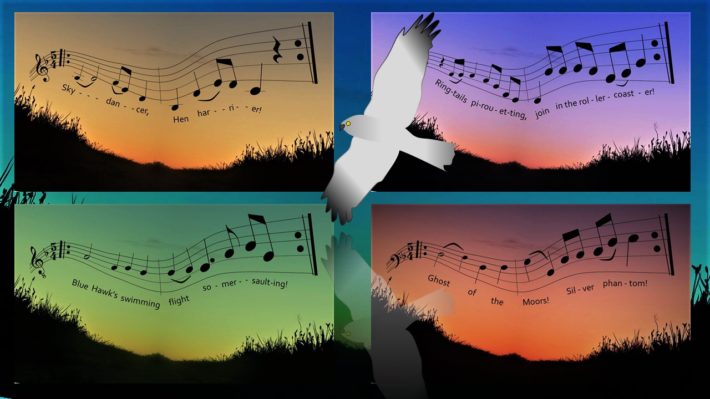
The first idea consists of four short repeating patterns which use nicknames and archaic names for the hen harrier, and briefly describe some of their remarkable flying habits. You could learn one or all of these.
The second musical idea is a melody which can be sung simultaneously with the repeating patterns. There are two verses which reflect on three notions: our enhanced perception of nature in general and birds in particular during this quieter lockdown period; the hope that this will foster greater empathy with nature in the future; and a memory of the hen harriers.
In between these two verses is the third music section which is a litany of the names of some of the recent disappearances of named and tagged hen harriers from Britain.
The Bridge Singers have created their own version of the song, and you can download the score they used and sing it yourselves exactly as they did.
However, you can also download a simplified score which contains all the elements of the song for you to mix and match in your own arrangement. You can record your own arrangement and send it to Hen Harrier Action using their link in this video and in the notes at the bottom, and they may share it on their website later in the year!
The other option you have if you don’t want to create your own recording or performance is to learn all the different elements of the song so that you can sing along with the video on Hen Harrier Day itself.
This learning video is designed to help you get to grips with the different musical ideas in the song. If you’re a quick sight-reader, you may not need to go any further with the video and go straight to the score now, but if you learn by ear, or a mixture of the two, it may be helpful to work your way through the rest of it!
Probably the easiest way to join in with the song is to learn one of the repeating patterns. Because The Bridge Singers is a 4-part choir, each of the four sections of the choir will sing a different pattern here, but you can choose whichever pattern you prefer and sing that. Let’s learn each one in turn. We’ll sing them a few times and you join in when you’re ready.
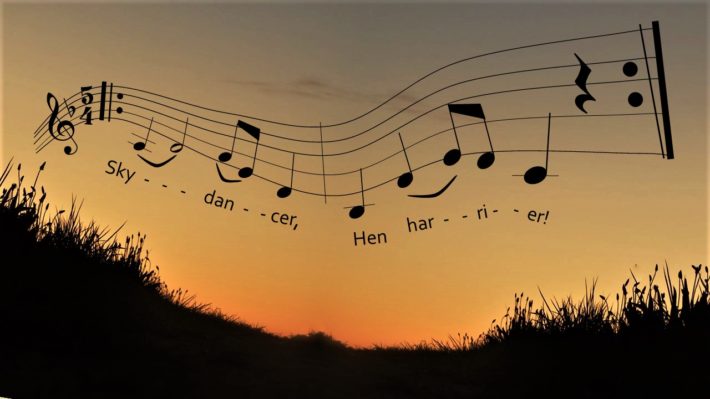
The first pattern uses the most well-known nickname for the hen harrier, inspired by their elaborate flight patterns: Skydancer, and is possibly the most tuneful of the four.
The second pattern, sung here by the tenors and includes the archaic name Blue Hawk as used by John Clare who also described their flight as “swimming close to the green corn”.
The sopranos sing the third pattern and refer to the ringtail or female hen harrier.
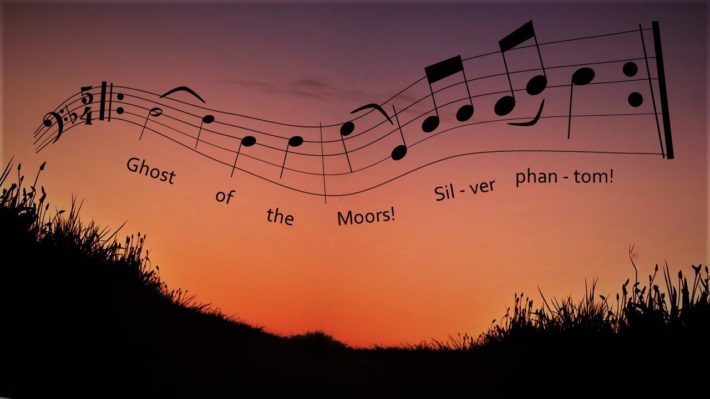
The final repeating pattern gives us two more nicknames: Ghost of the Moors, and Silver phantom.
Once you’ve mastered one or all of the repeating patterns you can sing them throughout most of the song as they fit very nicely with the 1st and 2nd verse melodies. However, before we tackle the melody for the verses, the middle section of the song probably provides another easier passage of music to join in with.
Jo sent me a long list of hen harriers who had been satellite-tagged and named in recent years, but have alas gone missing, with their fate unknown. In the list they are cited as “disappeared”. In the middle section, 24 of these birds are named interspersed with the word “disappeared”. It’s the same phrase of music six times, with just the names of the hen harriers altered. The music is in 4-part harmony. Let’s learn all four parts of that harmony for the first phrase of this section. We’ll sing each part three times. You sing along! Then we’ll fit all the harmony parts together.
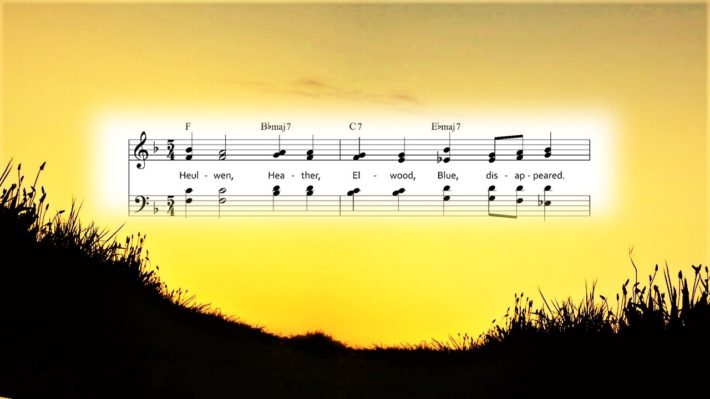
We’re going to try and fit all four harmony parts together now. Have a go at joining in and if you’re not sure, go back and practise again! I promise it gets easier, the more times you try it!
Now you’ll hear the whole of that section. Each list of names has virtually the same music as the first one you’ve already mastered, you just have to fit in different names, that’s all!
Right. Let’s have a go at the melody for verse 1. The trickiest thing about it is the rhythm, but as before, the more you listen to it and the more you sing along, the more you’ll get it into your system. The yellow spots will show you the way.
And now verse 2
If you’d rather not sing, but still want to join in you could play the chords during the verses. Gary has improvised a guitar part using the chords.
Or you could play this percussion part, or make up your own to fit.
During the “disappeared” section there is a melody to play – you can hear Alison playing it on her tenor recorder here. Or maybe you’d like to improvise your own melody instead. If you download one of the scores, you’ll find the whole melody.
There are lots of ways of joining in with this song for Hen Harrier Day, or any other time, for that matter. For scores and more information, do go to the Hen Harrier Day song page. The link is at the end of the video. Thanks so much for learning the song.

Go to the Hen Harrier Day website for scores of this song, and more information about how to participate in this or any of their other activities. Click here!
Update: August 2020.
Another choir did have a go at learning the song and their video can be viewed here!
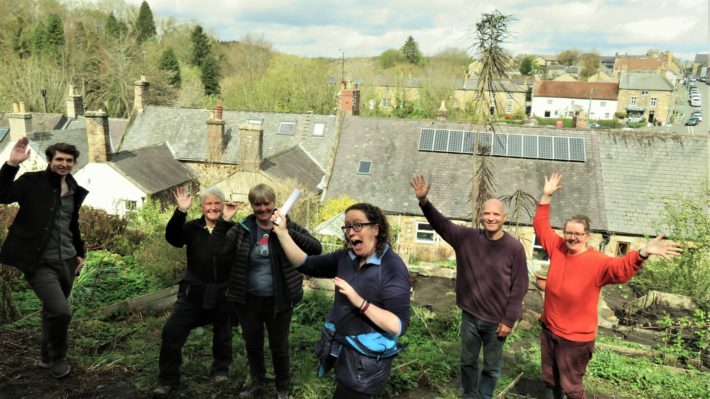
Update 9th May 2021.
Hen Harrier action had a mini Hen Harrier Day today. It was called Skydancer Day, so in honour of this and of the bird itself and our choir’s part in last year’s main event, six of us gathered at the top of our garden to sing the song to the village below – no-one was listening, I’m sure, but it made us very happy to sing together and to sing this song together rather than recording our own parts individually!

No comments yet.